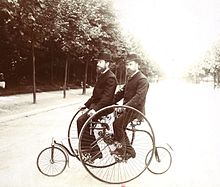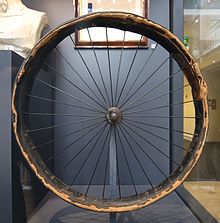Adolphe Clément
Gustave-Adolphe Clément , from 1909 Clément-Bayard (* 1855 in Pierrefonds , France , † 1928 in Paris ), was a French engineer , inventor and industrialist . He produced tires and built bicycles , engines , motorcycles , automobiles and airships . He is considered to be one of the pioneers of both automotive engineering and airship travel .
Life
Clément, the son of a grocer, showed an early interest in mechanics and technology . At the age of 17 he built his first bicycle with wooden wheels. After completing an apprenticeship as a locksmith , he founded the small bicycle workshop A. Clément & Cie . In Paris in 1878 at the age of 23 not far from Place de l'Étoile . In 1889 he bought John Boyd Dunlop , the inventor of the air-filled tire, for 50,000 francs the exclusive rights to manufacture and sell bicycle tires in France, thereby establishing his wealth.
In 1891 he separated from the partners of his company and planned to build a new factory, which became known as La Macérienne , on a former military site which had already been cheaply acquired in 1890 in the Faubourg Saint-Julier, at the foot of the citadel of Mézières ( Ardennes department ) . Clément monitored the progress of the construction work, which began in 1894, from a distance using photos taken daily. Once a week Clément went to Mezieres himself. In 1897 the factory, which had its own foundry and a workshop for nickel plating on a floor area of 15,000 m 2 in addition to a hydraulic turbine power station, a steam engine room and a large machine building hall, began manufacturing bicycle bolts and spokes . The factory buildings still exist. In the spring of 2006 a competition was announced to transform it into a cultural center.

At the same time, Clément merged with Lord Charles Chetwynd-Talbot, Earl of Shrewsbury (Lord Talbot, 1860-1921), behind whom the financially strong British Automobile Commercial Syndicate Ltd stood, and the French subsidiary of " Humber " to form a group of companies. In 1896, they bought the renowned French bicycle factory Société Gladiator, which had been founded five years earlier before Alexandre Darracq and Auroc . Clément used his position as chairman of the group to rename the French branch Clément-Gladiator and the English branch Clement-Talbot . In 1897 the engineer Leneveu was commissioned to build a second factory in Levallois-Perret , a western suburb of Paris. There Clément built his first mono-cylinder automobiles under the "Gladiator" brand.
The group disintegrated in 1903. While Sir Talbot took over the newly founded company Clement-Talbot Ltd , Clément sold the licenses for his motor vehicles and in turn founded a new company with a plant in Picardy . He gave this and henceforth also his car models the double name Clément-Bayard in memory of Pierre du Terrail , Chevalier de Bayard, the knight without fear and blame , who in 1521 under Francis I opposed the city of Mézières, where Cléments foundry was located the army of Charles V had defended. His son Albert Clément started in his father's vehicles in 1904 and finished third in the Ardennes race in 1904 and second in the Vanderbilt Cup in 1904. In the 1905 season he always failed due to the lack of reliability of his vehicles, but in the 1906 French Grand Prix he was able to take third place. When his son had a fatal accident during training before the French Grand Prix in 1907 in Dieppe, the father lost interest in motorsport and the Clément-Bayard brand disappeared from the racetracks.
In 1908 Clément built his first airship and named it "Clément-Bayard". From 1908 he also built 50 examples of the Demoiselle , a sport airplane, in collaboration with Alberto Santos-Dumont , of which only 15 were sold. In 1909 he changed his family name from Clément to Clément-Bayard. In 1914 he retired from his company. In the same year, on the occasion of a French government contract for the construction of airship hangars , he undertook a multi-day trip to Germany, where he made a tour with the airship "Sachsen" over Potsdam and Berlin and visited other halls in Frankfurt, Hamburg, Cuxhaven and Cologne. He was then arrested in Cologne with three companions, exposed to charges of industrial espionage , but released one day later. The incident reflects, among other things, the generally tense atmosphere that prevailed in the months before the outbreak of the First World War .
In 1921 he made the acquaintance of André Citroën . The conviction that Citroën would make the automobile popular led him to give Citroën financial support and to make his plant in Levallois-Perret available to him, which was taken over by Citroën in 1922 . Shortly before, "La Macérienne" had also been sold.
Adolphe Clément died in Paris in 1928.
Awards
- 1912: Commander of the Legion of Honor
- 2005: Posthumous honor, on the occasion of the centenary of the Geneva Motor Show , by minting a 50 CHF special gold coin with the motif "Clément 1905" (mint of the Swiss Confederation swissmint based on a design by the Bern artist Roger Pfund ).
Clément gladiator
Shortly after buying the " Gladiator " company, Adolphe Clément built his first motor vehicle in the new factory in Levallois-Perret, which was demolished in 1988 with the exception of one of the workshops and the machine shop, which was driven by the Clément-Michaux rear-mounted engine. the 2 3 / 4HP. This was followed in 1898 by the Clément-De Dion Phaëtonnet , a simple voiturette with a 2¼HP De Dion-Bouton single-cylinder engine .
In the 1890s, Adolphe Clément was also a member of the board of the automobile manufacturer Panhard & Levassor (P&L). In this position he became aware of a new design that P&L chief engineer Arthur Constantin Krebs had been working on since around 1897. It was a somewhat larger Voiturette that was consistently developed as a lightweight automobile. Because the existing systems at P&L were not sufficient to meet the demand for their own, larger automobiles, series production was dispensed with and Clément was able to acquire a license to replicate. After a few pre-series copies were made in Levallois-Perret in 1898, production of the Clément-Panhard Type VCP with a specially designed P&L single-cylinder engine from 3 to 3½HP started in early 1899 . The engine was a further development of the Daimler engine, whose exploitation rights for France were held by Panhard & Levassor. This type was produced in parallel with the Phaêtonnet in 1899 . Although the type VCP was not without problems, around 300 copies were made by 1902, which was a large number at that time. The Humber received a second license for Great Britain, whose subsidiary Stirling Motor offered the vehicle with the same technology but different bodies made in Great Britain as Clément-Stirling or Stirling-Panhard . In 1901 Adolphe Clément also built automobiles with 2 cylinders with 9 HP and 4 cylinder models with 12 or 16 HP.
The importer of Adolphe Clément's motor vehicles in Great Britain was initially the English company "Napier" and in 1902 Lord von Shrewsbury and Talbot, now president of "British Automobile Commercial Syndicate Ltd." In 1903 he took over the British branch of the group, which built its own models under other brand names such as Austin or Swift .
Clement-Bayard
The emblem of the third factory, newly founded by Adolphe Clément in 1903 after he left the Clément-Gladiator-Humber group in Trosly-Breuil (La Motte-Breuil) near Compiègne ( Département Oise ) and the models to be produced there in the future, was the statue of Chevalier Bayard . Its motto "without fear and blame" served as the slogan for the motor vehicles. In addition to the production of automobiles, the company built at least six airships from 1908 , initially in cooperation with the Astra Torres company . On November 1, 1908, the airship "Clément-Bayard", which took off from Sartrouville at 11:15 am, covered a total of around 250 kilometers in 4 hours and 53 minutes to Pierrefonds and back via Paris and Auteuil, thus breaking the record of the closed sightseeing flight. With the airship "Clément-Bayard" N ° 2, the first crossing of the English Channel was achieved on October 16, 1910. When the First World War broke out, the French army had three "Clément-Bayard" models with a total of six airships.
In 1914 the company founder withdrew from the company, which was taken over by Citroën in 1922 .
Clement-Talbot Ltd.
The main shareholders of the new company Clement-Talbot Ltd in Great Britain were Lord Talbot, Adolphe Clément, A. Lucas, and E. Lamberjack. The new company, which built a factory in Ladbroke Grove in west London , was directed by DM Weigel. Initially, automobiles were built that were identical to those of the models made in France. Only in 1907 were own models made in Great Britain.
Financier of L'Auto
Annoyed by Pierre Giffard's Le Vélo sports gazette , Clément helped finance a competing newspaper that first appeared in October 1900 as L'Auto-Vélo . His advertising manager Henri Desgrange , a well-known cyclist and promoter, became the first editor-in-chief at Clément's suggestion. In addition to Clément, Count de Dion ( De Dion-Bouton ), André Michelin and Édouard Michelin contributed to the financing of the paper with considerable amounts; the detour into the newspaper industry ultimately also paid off financially. The Dreyfus affair was the trigger for the establishment of the newspaper ; Giffard was in favor of the officer's release and was very direct on his opponents. But there were also strong economic interests, Le Vélo practically exercised a monopoly in vehicle and accessory advertising; Giffard preferred his own investor Alexandre Darracq.
literature
- Peter Joffre Nye: The Fast Times of Albert Champion: From Record-Setting Racer to Dashing Tycoon, An Untold Story of Speed, Success, and Betrayal , Prometheus Books, 1st edition, 2014; ISBN 978-1-616-14964-2 .
- Anthony Bird: De Dion Bouton - First automobile Giant. Ballantine's Illustrated History of the Car marque book No 6, Ballantine Books, New York 1971.
Web links
- Adolphe Clément-Bayard on the website of the tourist office of his hometown Pierrefonds (French)
- Adolphe Clément's work "La Macérienne" in Mézières on the website of the "Association La Macérienne" (English / French)
- Clément-Bayard airships
- Airship Clément-Bayard N ° 2 in front of the airship hangar at Trosly-Breuil ( Memento from September 27, 2007 in the Internet Archive )
- Court case Clément-Bayard # Cocquerel regarding the airship hangar ( memento of December 25, 2004 in the Internet Archive ) (French; PDF; 188 kB)
- Adolphe Clément in the Radsportseiten.net database
Individual evidence
- ↑ The change of the family name Clément to Clément-Bayard was approved by the State Council in 1909.
- ↑ 20 rue Brunel, 75017 Paris.
- ↑ The photos taken during the construction of the "Macérienne" are in the archives of the Ardennes department.
- ↑ 48 to 58 Quai Michelet, 136 to 140 rue Anatole-France, 20 rue Greffulhe.
- ↑ Jürgen W. Schmidt: Caught in the act and released anyway. In: Preussische Allgemeine Zeitung , edition 25/14. June 21, 2014, accessed October 8, 2014 .
- ^ "Quid", 1986, Paris, Editions Robert Laffont.
- ^ A b Peter Joffre Nye: The Fast Times of Albert Champion: From Record-Setting Racer to Dashing Tycoon, An Untold Story of Speed, Success, and Betrayal , Prometheus Books, 1st edition, 2014; ISBN 978-1-616-14964-2 .
- ^ Bird: De Dion-Bouton. 1971, pp. 49-50.
| personal data | |
|---|---|
| SURNAME | Clément, Adolphe |
| ALTERNATIVE NAMES | Clément, Gustave-Adolphe (full name); Clement-Bayard, Adolphe |
| BRIEF DESCRIPTION | French engineer, inventor and industrialist |
| DATE OF BIRTH | 1855 |
| PLACE OF BIRTH | Pierrefonds , France |
| DATE OF DEATH | 1928 |
| Place of death | Paris |


